SCORM vs AICC: What is the Difference?
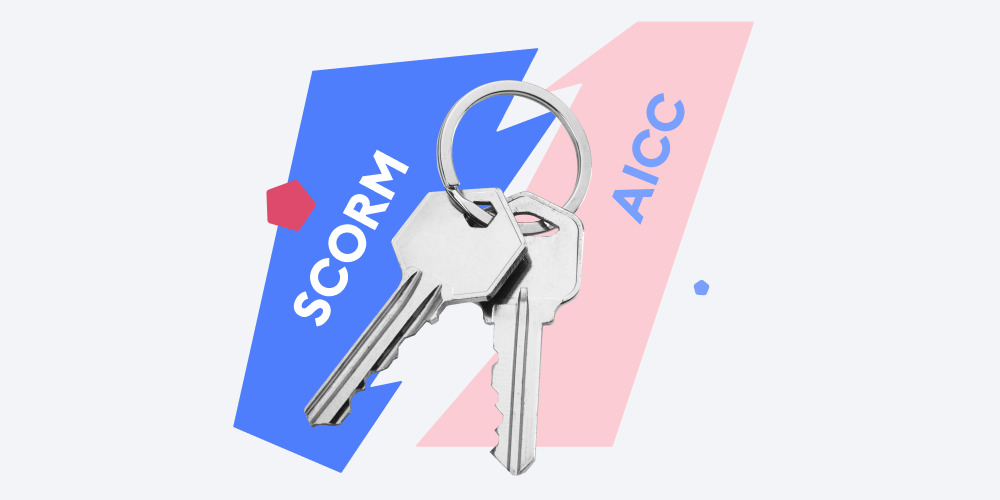
Whether you’re a seasoned eLearning content creator or a newbie, you might have come across the acronyms SCORM and AICC in the course authoring process. Both learning technology standards are used in authoring tools and learning management systems (LMS), but how do they compare? Is one better than the other? Should you even care which standard to work with?
To help you get clear answers to these questions, we’ve created this detailed SCORM vs AICC guide. It provides insight into the two standards’ functionalities, compatibility, and pros and cons. Knowing these differences will come in handy when creating eLearning content or picking the right learning management system for your learning projects.
Let’s dive right in!
Overview
AICC vs SCORM: The Key Differences
Choosing the Right eLearning Standard for Your Learning Projects
What is AICC?
AICC is a set of standards used for traditional eLearning content development and management.
The acronym stands for Aviation Industry Computer-Based Training Committee. Now, you might be wondering what the aviation industry has to do with eLearning. The thing is, AICC built the first eLearning standards in 1988, which were initially designed for the aviation industry. Later, they found use across various sectors for creating and managing online training content and web-based training.
How does AICC work?
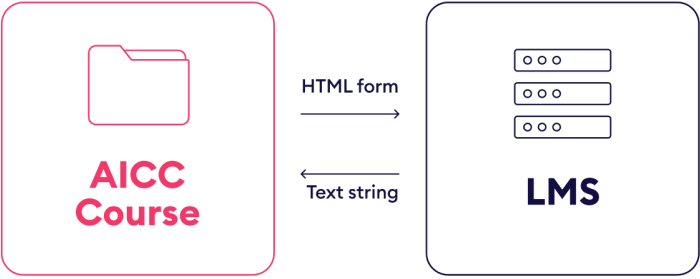
AICC works by defining how learning content communicates with learning management systems. It uses an HTTP AICC communication protocol that allows courses to send information, including course completion status or assessment scores, to the LMS. This way, the content and system can interact, and you can track learning progress effectively.
AICC Pros
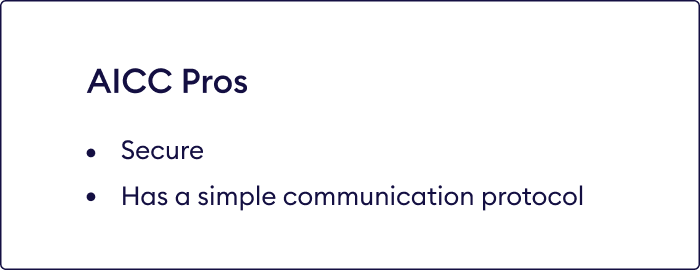
This set of technical standards, although old, does have its strong suits:
- It’s very secure. AICC provides secure data transfer of your eLearning course to an LMS. That’s a big pro if your learning contains sensitive information.
- It has a simple communication protocol. It uses HTTP/HTTPS for communication, which can be easier to implement than other standards.
AICC Cons
However, AICC has major drawbacks you should consider.
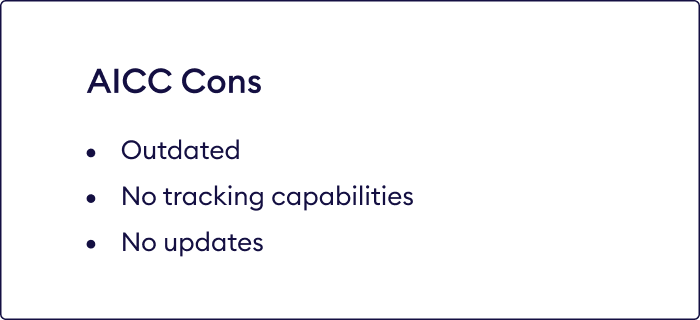
- It is an outdated standard. Modern authoring tools don’t use AICC as much, and finding an AICC compliant LMS can be challenging.
- It has very limited tracking capabilities. You can’t track learner progress or get insights into completion rates with AICC compliance.
- It lacks updates. AICC hasn’t received updates since 2014.
Bottom line: AICC is an earlier, less robust eLearning standard that was once a pioneering development but has practically lost its relevance entirely.
What is SCORM?
SCORM (short for Sharable Content Object Reference Model) is another collection of standards that helps eLearning content and LMSs communicate and work together effectively.
SCORM was created by the US government’s Advanced Distributed Learning project for the eLearning industry in 2000. It addressed the issues that were relevant for older standards at the time, including inconsistent tracking and reporting capabilities.
How does SCORM work?

SCORM allows you to upload your eLearning materials to an LMS as a zip file. The zip archive contains structured multimedia, HTML, and XML files for the correct interaction with the LMS. SCORM-compliant courses are embedded with the JavaScript Application Programming Interface.
SCORM standards have different versions: SCORM 1.2 is the most widely used version, along with SCORM 2004, which is slightly less popular.
SCORM Pros
SCORM has several benefits that make it a highly popular eLearning standard:
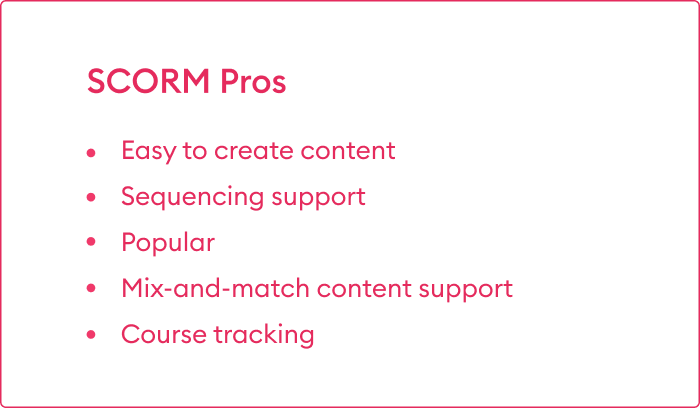
- It’s easy to create SCORM content. Most SCORM compliant authoring tools, like iSpring Suite, are extremely intuitive and easy to master – even for beginners.
- It allows you to set sequencing rules. You can “tell” a SCORM course how much time learners need to spend on a slide or the entire course.
- It’s popular. Most of today’s LMSs are SCORM compliant, which means you can easily upload your eLearning courses to an LMS and assign them to learners right away.
- It’s perfect for mixed-source online courses. With SCORM, you can combine training materials created in one authoring tool with SCORM compliant courses from a different tool within the same package.
- It has progress-tracking functionalities. You can see course completions, the time learners spent on a course, and assessment scores.
SCORM Cons
This technical standard comes with a few major limitations:
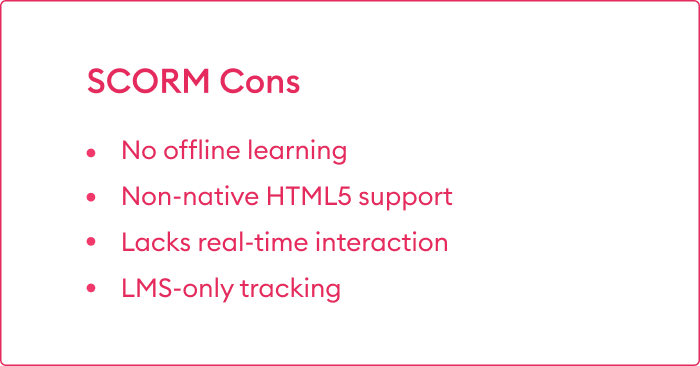
- It doesn’t support offline learning. Learners can’t take SCORM courses without a stable internet connection.
- It has non-native HTML5 support. Originally built for Flash, SCORM might face problems in using the full set of features of HTML5. This can make it tricky to create content that works well on modern devices that mostly support HTML5.
- It lacks real-time interaction. SCORM is designed for data tracking and reporting after completion. This means that real-time interactions, such as collaborative activities, are more difficult to implement effectively.
- It only supports tracking via LMS deployment. If you want to monitor learners outside of the traditional LMS setup, SCORM may not be the most suitable choice.
Bottom line: SCORM is a well-recognized industry standard that offers course tracking and sequencing possibilities.
AICC vs SCORM: The Key Differences
As you can see, both the SCORM and AICC eLearning standards have their strengths and weaknesses. In a nutshell, AICC is a more outdated standard with limited LMS deployment and tracking possibilities, while SCORM is more robust and still widely used in the industry. But let’s look at the comparison factors more closely.
SCORM vs AICC: A comprehensive comparison chart
| Parameters | AICC | SCORM |
| Structure | Single file-based | Modular, multiple files (package) |
| Content packaging | Course in a single file | Content organized into smaller reusable objects |
| Communication | Uses HTTP/HTTPS protocol | Uses JavaScript and API calls |
| Adoption | Historically used in specific industries | Widely adopted across various sectors |
| Flexibility | Less flexible in content integration | More flexible due to the modular structure |
| Mobile learning support | Limited or may require additional customization | Limited native support; may need adaptation for mobile devices |
| Offline learning support | Typically lacks built-in offline capabilities | May require customization to provide offline learning |
| Course tracking | Very limited | Course completions, time spent on a course, assessment scores |
| Course sequencing | Doesn’t support sequencing | Supports course sequencing management |
| Reporting capabilities | Very limited | Limited |
| HTML5 support | Typically lacks native support for HTML5 | Non-native HTML5 support |
| LMS deployment | Depends on LMS compatibility | Designed for seamless LMS deployment |
Choosing the Right eLearning Standard for Your Learning Projects
While AICC is still used in the eLearning industry, SCORM is today’s default technical standard for delivering online courses. Most modern LMSs like iSpring LMS support this standard, so you’ll be safe choosing SCORM.
Some learning management software can also support newer eLearning standards, such as xAPI, cmi5, and IMS Common Cartridge. These standards can provide more robust learner progress tracking functionalities. This is especially true for xAPI, thanks to the Learning Record Store (LRS), a unique feature that records all learning activities and shares them with other LRSs, including those in an LMS. To learn more about this standard and its comparison to SCORM, read our detailed article on SCORM vs. xAPI.
Here’s another thing to keep in mind: some eLearning software vendors develop their own eLearning standards. iSpring LMS is a great example: besides supporting SCORM, it has employed a unique, xAPI-based eLearning tracking format that allows you to register many more course progress metrics than AICC or SCORM.
While SCORM only tracks completions, time spent on a course, and assessment scores, the iSpring LMS’s standard can show you how many times an assessment was attempted and how learners answered each test question. This way, you can identify the existing learning gaps precisely and build personalized learning tracks to close these gaps effectively within corporate training or other learning initiatives.
An extra perk of this in-house standard: if you’re using iSpring Suite to build your courses, you can upload them directly to the iSpring LMS without having to save content as a specific eLearning standard.
FAQ on SCORM vs AICC
Read on to find answers to frequently asked questions about SCORM and AICC.
Is SCORM outdated?
No. While some modern learning developers think SCORM is becoming a thing of the past, it’s still widely used in the eLearning industry to build interactive course content that works well in most LMSs.
New standards are gaining popularity and may replace SCORM in the future, but it’s not a swift or universal transition.
What is an AICC file?
An AICC file refers to the format used for Aviation Industry Computer-Based Training Committee (AICC) standards. It typically contains structured data for eLearning content to facilitate communication between the content and a learning management system (LMS).
What is the difference between SCORM, AICC, and xAPI?
SCORM, AICC, and xAPI are all standards used in the eLearning industry but differ in their approaches to tracking and managing learner data. SCORM and AICC are older standards that focus on the communication between a simple working eLearning course and a learning management system (LMS).
xAPI (Experience API), also known as Tin Can API, is a more modern and flexible standard that goes beyond traditional course-based learning. xAPI allows the tracking of a broader range of learning experiences, including informal and offline activities.
Final Thoughts
Now you know what AICC and SCORM are and how these two eLearning standards compare. SCORM is a more widely recognized format with better course tracking functionalities, while AICC is becoming a legacy standard that once pioneered the industry.
If you want to have freedom of choice and try working with both standards, author your eLearning courses with iSpring Suite. This comprehensive course creation tool supports SCORM 1.2, SCORM 2004, AICC, xAPI (Tin Can), and cmi5. Try iSpring Suite for free with a 14-day trial and create engaging, professional-looking eLearning courses with ease.



